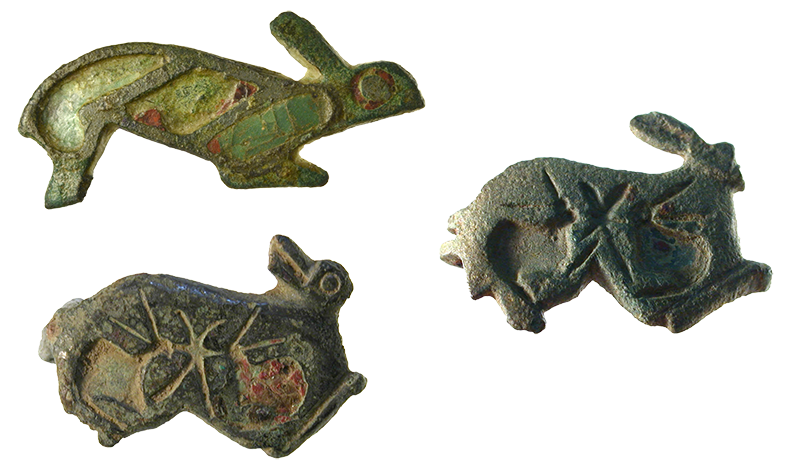This week we bring you three Roman brooches in the style of rabbits (or hares) recovered in Suffolk by local metal detector users.
All three are known as ‘plate brooches’ because they are characterised by a flat plate, the front face of which is usually decorated with enamel inlay. These seem more decorative and less functional than the more common safety pin shapes of many Roman brooches.
Plate brooches depicting animals were quite common in the Roman period, especially in the second century AD. Some may be linked to religious practice, perhaps sold as mementos at temples.
The first brooch was recovered near Ousden. It depicts a hare or rabbit preparing to leap. The body is decorated with three recessed cells. The central cell contained traces of red enamel and the outer cells blue/green enamel. Cell designs are a feature of many Roman plate brooches.

The second and third brooches, are remarkably similar. The shape of each brooch is in the form of crouched adult rabbit or hare. On the front face are incised depictions of two young set either side of a central star. Each brooch shows traces of enamel in the bodies of the young. They were recovered from Gedgrave and Shimpling.


If these brooches were manufactured in Britain, they are likely to be hares rather than rabbits because archaeological evidence suggests that there were no sustained rabbit populations here until the Medieval period. Evidence for very occasional rabbits from Roman Britain includes six rabbit bones recovered from a Roman pit at Lynford in Norfolk, and recent re-analysis of animal bones from the Roman ‘palace’ at Fishbourne in West Sussex revealed the presence of a rabbit bone. This bone was radiocarbon dated to the 1st century AD and the lack of butchery marks on it possibly suggests that the rabbit was kept as a pet, likely in a tiled or walled enclosure the Romans called a ‘leporarium’.
View the full records on the Portable Antiquities Scheme database:
View the full record of SF-93372E hare brooch from Ousden
View the full record of SF-D91D84 hare brooch from Gedgrave
View the full record of SF-13BC11 hare brooch from Shimpling
Thank you to the finders for allowing these objects to be featured.
These finds were recorded by the Suffolk Finds Recording Team, supported by the Portable Antiquities Scheme.





